| View previous topic :: View next topic |
| Author |
Message |
MacTak

Joined: 15 Jun 2011
Posts: 108
|
 Posted: Wed Jun 15, 2011 5:28 am Post subject: Odd (Early?) "Micro Tamron" 70mm f5.6; Any Info? Posted: Wed Jun 15, 2011 5:28 am Post subject: Odd (Early?) "Micro Tamron" 70mm f5.6; Any Info? |
 |
|
MacTak wrote:
First let me say I'm a long time follower of the forums here (as a MF lover, particularly Pentax glass). I saw this lens on Ebay and as a MF lens lover, particulry macro lenses, I could not pass it up. But searching the internet I was not able to find any information on this lens (or anything except the auction listing).
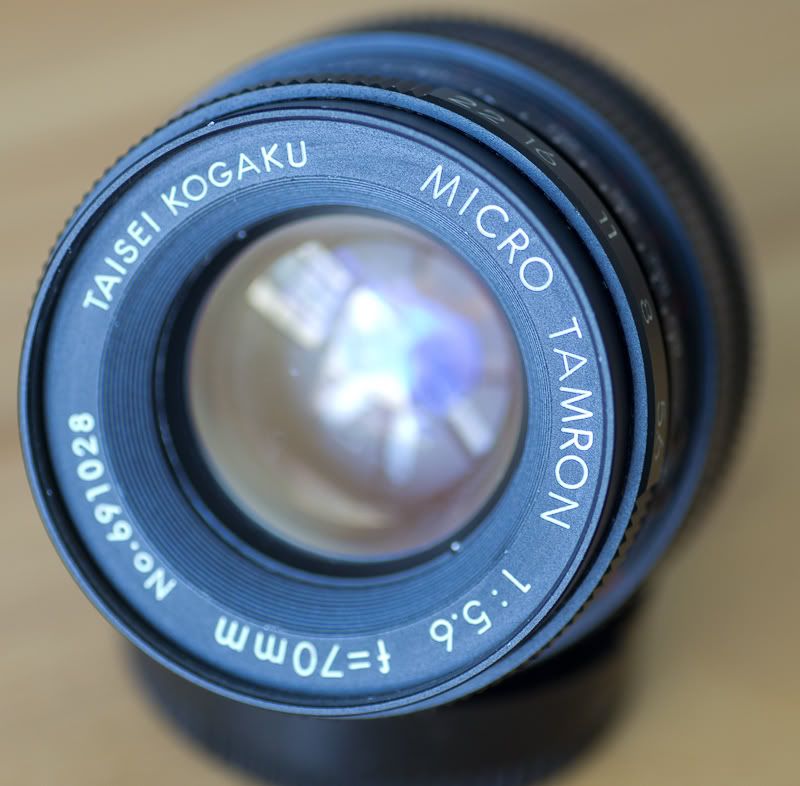
Aperture is directly controlled by the front ring. Middle ring is focus, last is just for grip. Aperture does have proper detents and half-stops. Focusing scale (metal, held on by screws) is in inches and cm goes from to 260cm/90in. Focuses down to 40cm/16in. Build is excellent--feels on par with my Takumars. Lens is coated. It seems like a muti-coating as well, but I'm not an expert on judging that.
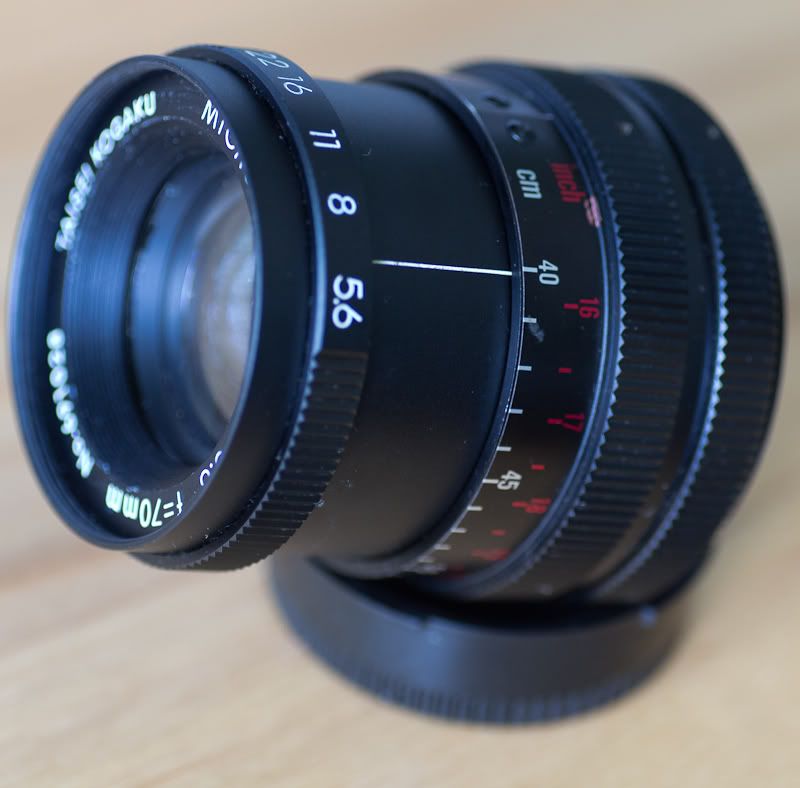
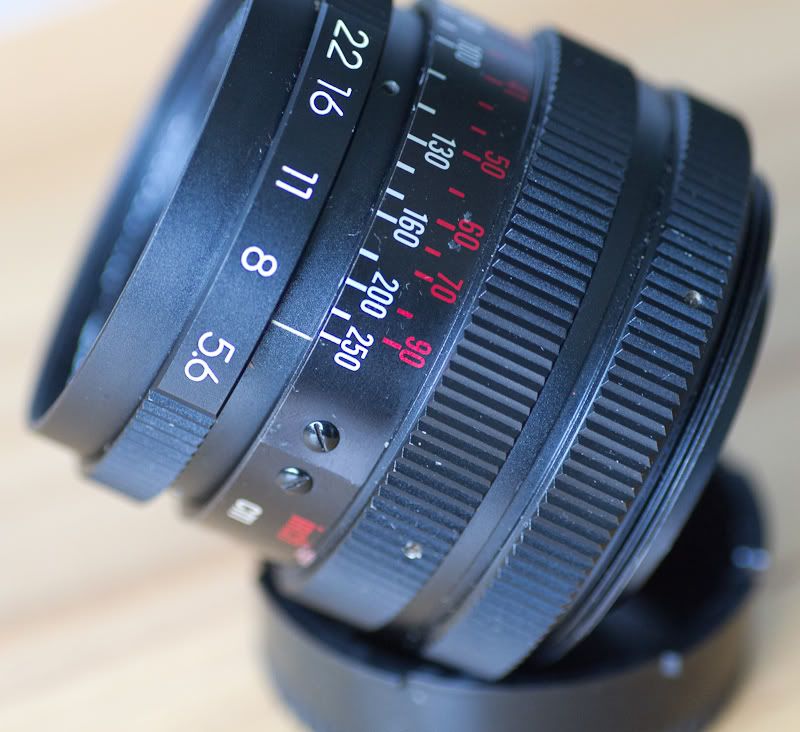
Even Tamron's old lens page (http://www.tamron.co.jp/data/old-lens/old-index.htm) does not list it. I rather suspect it is a medium format lens. With the Taisei Kogaku in the name, it's clearly an early Tamron lens. The lens is just under 2.5 inches long. Front filter is 52mm diamter, rear screw mount looks to be about 55mm in diameter. I have no idea what the mount of this lens is. The rear mount part itself is attached with screws, almost as though it was removable or easily factory made in different mounts. Note that there indeed screws partailaly visible under the rear baffle/opening.
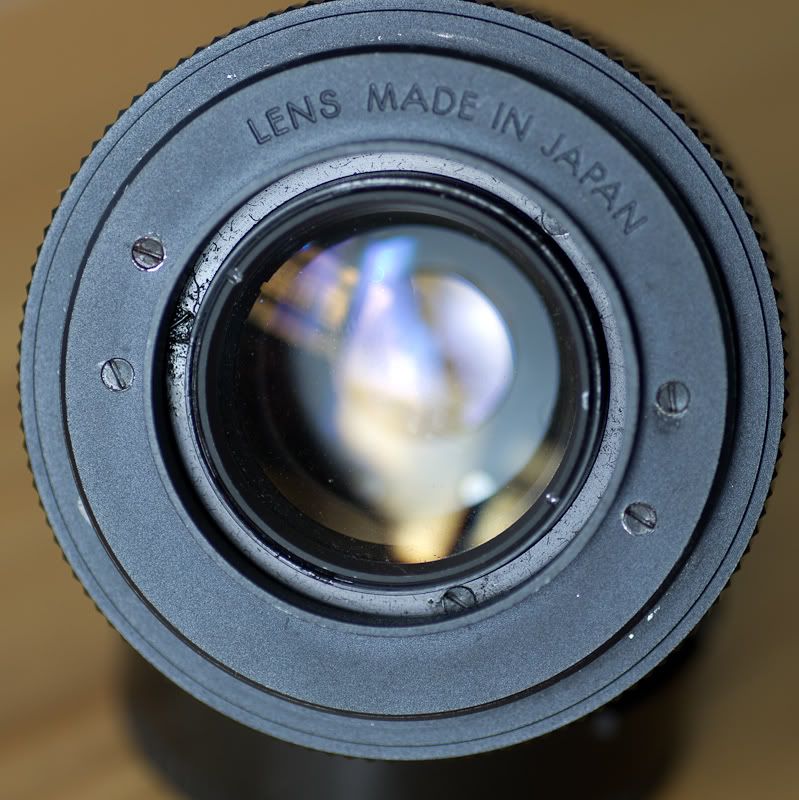
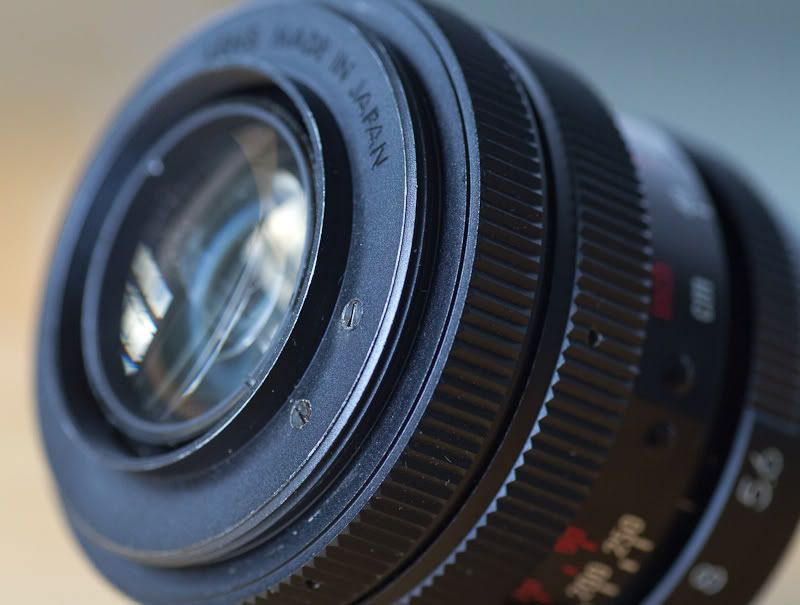
Aperature design is rather wierd--I've never seen any quite like it. 8 primary blades plus 8 secondary blades Here you can see it from the front. First wide open. Then stopped down.
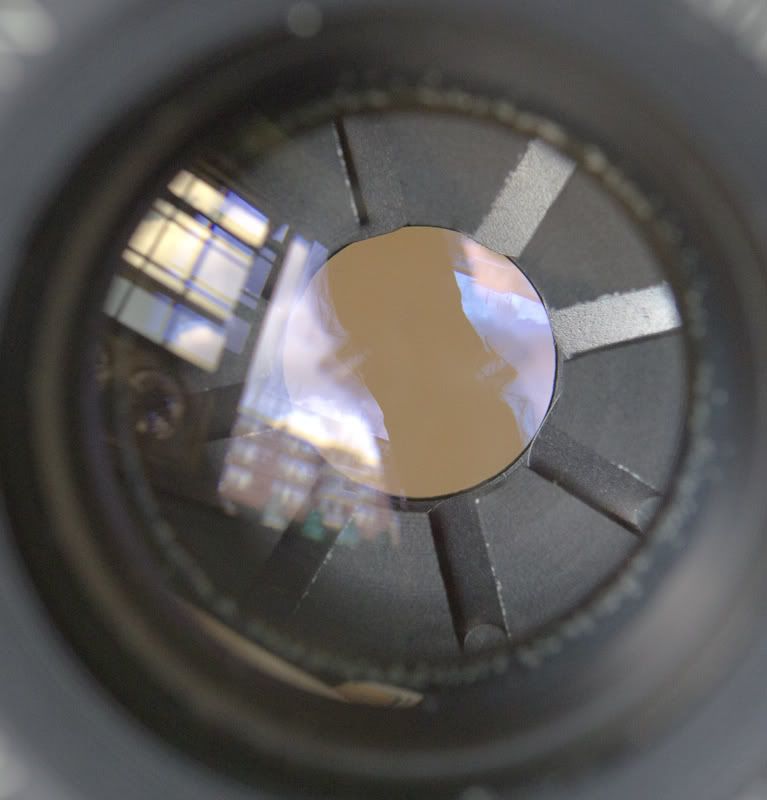
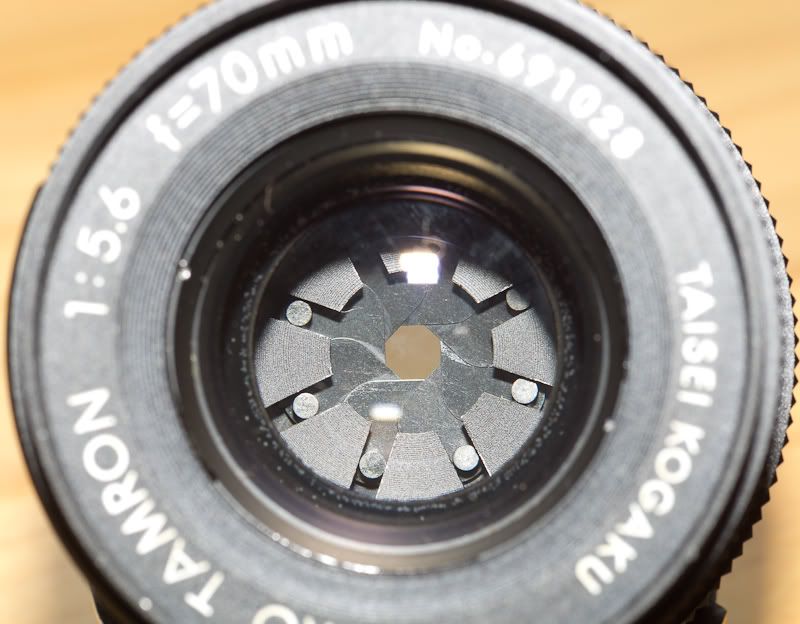
Now from the rear it gets even stranger. First, the rear side looks more like you'd expect the aperature to look from the front of a normal lens. Secondly, upon stopping down (particulry at the higher aperatures) a second set of 8 blades starts to emerge! As you can see, the are right underneath (thinking of the front of the lens as the top) the normal blades, not really visible when looking from above. But look carfully and you can see how the the pins (which hold the aperature blades) have moved in towards the center of the lens, and so these secondary blades actually fill in the gap that would otherwise be left as the top part of the aperature moves inwards.
Wide open:
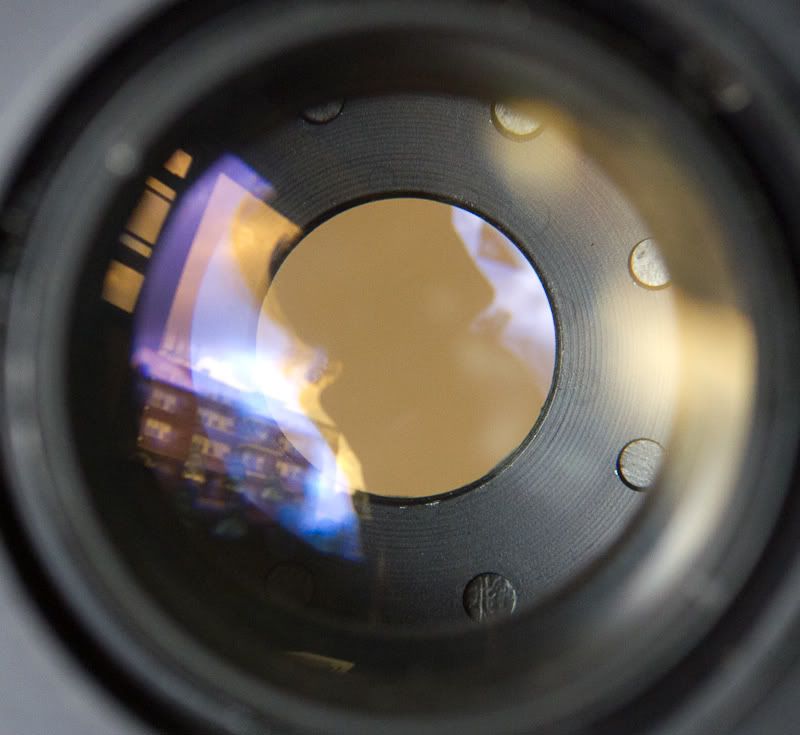
Fully stopped down:
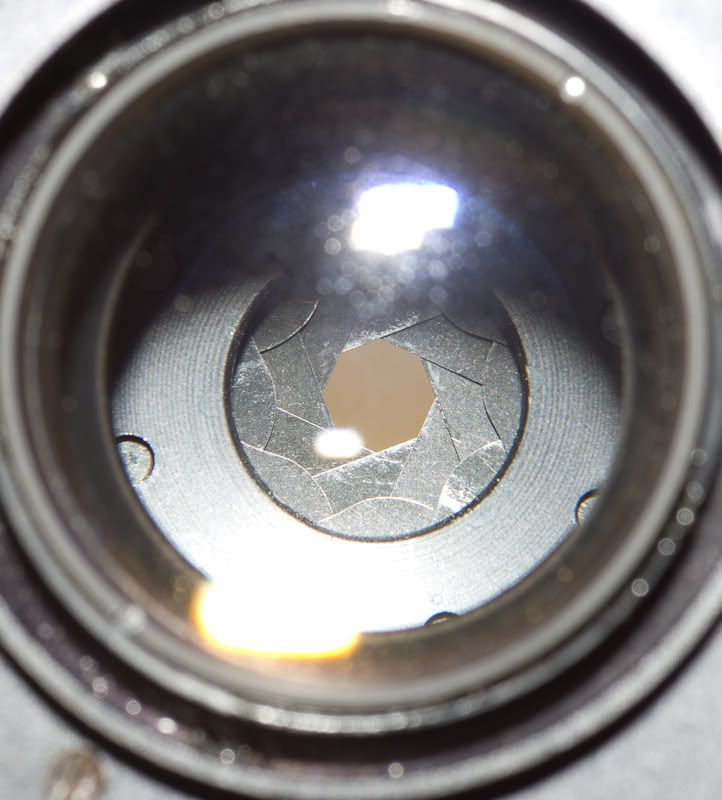
So, can anyone shed any light on this lens and the mount (not to mention how best I might adapt it to Pentax K or M42 or even M39). |
|
| Back to top |
|
 |
cooltouch


Joined: 15 Jan 2009
Posts: 9096
Location: Houston, Texas
|
 Posted: Wed Jun 15, 2011 5:46 am Post subject: Posted: Wed Jun 15, 2011 5:46 am Post subject: |
 |
|
cooltouch wrote:
Looks like you've found a real puzzler there, MacTak. Seems to me that any lens labeled "Micro" would focus closer than 16"/40cm. And that aperture iris seems like really excessive overkill. Very strange.
You can find out about its coverage, or image circle by just holding up to a wall in a room where there's a window opposite the wall. Let the sunlit image coming in from the opposite window fall on the wall. Focus the lens. This will tell you two things -- the size of the circle will tell you what sort of format coverage it can provide, and the distance from the rear element -- or rear lens flange to the wall will tell you the lens's registration distance.
It looks to be in very clean condition, especially since it dates from -- what do you figure? 1960s?
_________________
Michael
My Gear List: http://michaelmcbroom.com/photo/gear.html
My Gallery: http://michaelmcbroom.com/gallery3/index.php/
My Flickr Page: https://www.flickr.com/photos/11308754@N08/albums
My Music: https://soundcloud.com/michaelmcbroom/albums
My Blog: http://michaelmcbroom.com/blogistan/
Last edited by cooltouch on Wed Jun 15, 2011 5:42 pm; edited 1 time in total |
|
| Back to top |
|
 |
martyn_bannister


Joined: 23 May 2010
Posts: 1151
|
 Posted: Wed Jun 15, 2011 7:08 am Post subject: Posted: Wed Jun 15, 2011 7:08 am Post subject: |
 |
|
martyn_bannister wrote:
Certainly I can't find a reference to this lens in the Vade Mecum. 70mm doesn't seem to be a popular prime lens length. Judging by the unusual mount, would this be an enlarger or even a projector lens? |
|
| Back to top |
|
 |
ManualFocus-G


Joined: 29 Dec 2008
Posts: 6622
Location: United Kingdom
Expire: 2014-11-24
|
 Posted: Wed Jun 15, 2011 7:29 am Post subject: Posted: Wed Jun 15, 2011 7:29 am Post subject: |
 |
|
ManualFocus-G wrote:
Incredible first post, I've never even heard of this one before! Great find!
_________________
Graham - Moderator 
Shooter of choice: Fujifilm X-T20 with M42, PB and C/Y lenses
See my Flickr photos at http://www.flickr.com/photos/manualfocus-g |
|
| Back to top |
|
 |
martyn_bannister


Joined: 23 May 2010
Posts: 1151
|
 Posted: Wed Jun 15, 2011 7:59 am Post subject: Posted: Wed Jun 15, 2011 7:59 am Post subject: |
 |
|
martyn_bannister wrote:
What I find unnerving is that the focus scale goes from 90 - 16 inches - but no mention of infinity 
Surely this must be a projector or repro lens? A lens for an enlarger usually uses movement of the enlarger itself to focus and a camera lens would surely have an infinity focus mark? If it were a macro lens designed for bellows use then the focus scale is redundant and/or the numbers are meaningless?
Totally weird! Would be great to find out what the register distance is and how it performs 
PS - it might be worth mailing tamron themselves with a link to this thread to see if they can shed any light on it. Might be one for their museum  |
|
| Back to top |
|
 |
M. Valdemar

Joined: 14 Nov 2008
Posts: 93
|
 Posted: Wed Jun 15, 2011 11:38 am Post subject: Posted: Wed Jun 15, 2011 11:38 am Post subject: |
 |
|
M. Valdemar wrote:
I think that lens was probably part of a macro bellows system. Spiratone sold similar set-ups.
 |
|
| Back to top |
|
 |
kds315*


Joined: 12 Mar 2008
Posts: 16625
Location: Weinheim, Germany
Expire: 2021-03-09
|
 Posted: Wed Jun 15, 2011 11:57 am Post subject: Posted: Wed Jun 15, 2011 11:57 am Post subject: |
 |
|
kds315* wrote:
I would agree on that, most likely for a repro bellows system.
Interesting lens, would fit my macro-lens collection 
_________________
Klaus - Admin
"S'il vient a point, me souviendra" [Thomas Bohier (1460-1523)]
http://www.macrolenses.de for macro and special lens info
http://www.pbase.com/kds315/uv_photos for UV Images and lens/filter info
https://www.flickr.com/photos/kds315/albums my albums using various lenses
http://photographyoftheinvisibleworld.blogspot.com/ my UV BLOG
http://www.travelmeetsfood.com/blog Food + Travel BLOG
https://galeriafotografia.com Architecture + Drone photography
Currently most FAV lens(es):
X80QF f3.2/80mm
Hypergon f11/26mm
ELCAN UV f5.6/52mm
Zeiss UV-Planar f4/60mm
Zeiss UV-Planar f2/62mm
Lomo Уфар-12 f2.5/41mm
Lomo Зуфар-2 f4.0/350mm
Lomo ZIKAR-1A f1.2/100mm
Nikon UV Nikkor f4.5/105mm
Zeiss UV-Sonnar f4.3/105mm
CERCO UV-VIS-NIR f1.8/45mm
CERCO UV-VIS-NIR f4.1/94mm
CERCO UV-VIS-NIR f2.8/100mm
Steinheil Quarzobjektiv f1.8/50mm
Pentax Quartz Takumar f3.5/85mm
Carl Zeiss Jena UV-Objektiv f4/60mm
NYE OPTICAL Lyman-Alpha II f1.1/90mm
NYE OPTICAL Lyman-Alpha I f2.8/200mm
COASTAL OPTICS f4/60mm UV-VIS-IR Apo
COASTAL OPTICS f4.5/105mm UV-Micro-Apo
Pentax Ultra-Achromatic Takumar f4.5/85mm
Pentax Ultra-Achromatic Takumar f5.6/300mm
Rodenstock UV-Rodagon f5.6/60mm + 105mm + 150mm
|
|
| Back to top |
|
 |
aoleg


Joined: 22 Feb 2008
Posts: 1387
Location: Berlin, DE
|
 Posted: Wed Jun 15, 2011 1:35 pm Post subject: Posted: Wed Jun 15, 2011 1:35 pm Post subject: |
 |
|
aoleg wrote:
I've seen a similar arrangement with two sets of aperture blades on some Russian lenses, notably Helios-40. I, too, think it's excessive overengineering; it seems the designers used this arrangement to provide for linear movement of aperture control ring (that is, to keep ring travel the same between, say, f/2-2.8 and f/11-16).
_________________
List of lenses |
|
| Back to top |
|
 |
MacTak

Joined: 15 Jun 2011
Posts: 108
|
 Posted: Wed Jun 15, 2011 3:25 pm Post subject: Posted: Wed Jun 15, 2011 3:25 pm Post subject: |
 |
|
MacTak wrote:
Thanks for all of your replies so far. Yes, it's quite the puzzling lens, so I had to finally join up to share. The focusing distance was (and still is) the biggest puzzle for me. It seems odd for a such a distance either for macro work (per the lens name) or in general (no infinity). My first thought when I saw a photo of the lens (before I read that it had a focusing helicoid) was that it was an enlarger lens. The focal length and speed, micro name, and manual aperture ring at the front all most closely resemble an enlarging lens. But then it has the helicoid.... It's very strange for a normal lens to just have a manual (non preset) aperture ring at the front. A reproduction bellows lens makes some sense, but I still fail to see the point of designing the lens with a helicoid then. Also, why does it have such a sizable 55mm mount then? I see no great reason to make a bellows system with such a mount instead of M42/M39/T2, etc., and certainly this lens could have such a mount size. And let's not forget Tamron (which seems quite exacting about listing every lens they ever made) does not list the lens at all--pity I don't know Japanese or I'd write them. Anyone who does is welcome to (or give me a heads up if you know a contact in english).
I'll see if I can try the format test as soon as I can--unfortunately my apartment doesn't get the best direct sunlight, but I'll see what I can do. I will add that while I can't say much about the optical design, it looks to me that there are at least two elements in front of the aperture and at least two behind.
Originally I was thinking of adapting it, but short of gluing on a flanged K-mount adaptor, I don't think there is any good way to do it, and since the lens is indeed so rare, I think that would be a crime to lens-kind to do so. Pity I don't have a reversing ring right now. I try *not* to be a pure collector, so much as a user who accumulates enough lenses to probably be called a collector, so I wouldn't be opposed to seeing this happily in a collection or the Tamron museum  |
|
| Back to top |
|
 |
martyn_bannister


Joined: 23 May 2010
Posts: 1151
|
 Posted: Wed Jun 15, 2011 4:44 pm Post subject: Posted: Wed Jun 15, 2011 4:44 pm Post subject: |
 |
|
martyn_bannister wrote:
| MacTak wrote: |
And let's not forget Tamron (which seems quite exacting about listing every lens they ever made) does not list the lens at all--pity I don't know Japanese or I'd write them. Anyone who does is welcome to (or give me a heads up if you know a contact in english).
|
I am sure we'd all be surprised how many of their employees speak english.
I'd give them a go anyway  |
|
| Back to top |
|
 |
luisalegria


Joined: 07 Mar 2008
Posts: 6602
Location: San Francisco, USA
Expire: 2018-01-18
|
 Posted: Wed Jun 15, 2011 9:36 pm Post subject: Posted: Wed Jun 15, 2011 9:36 pm Post subject: |
 |
|
luisalegria wrote:
Joining all the rest in appreciation of this unique find !
Thanks for showing it to us !
Tamron hasn't fully documented all the lenses they made, not by a long shot. There are plenty of ordinary SLR lenses they have not included on their site, nor have they been listed on the Adaptall-2 site. I have several.
Among other things they have not listed the specialized lenses they made for many commercial purposes. One of them is a monster zoom they made for Camerz medium-format portrait cameras.
This looks like another lens made for a specialized camera, obviously one designed for close focus. I suspect it wasn't a repro camera, but who knows. The 55mm thread seems like something made for a unique mount.
It may be possible to easily mount this on an SLR, depending on the back focus. One way would be to use a 55mm-55mm F-F adapter plus a reverse adapter for the desired mount.
_________________
I like Pentax DSLR's, Exaktas, M42 bodies of all kinds, strange and cheap Japanese lenses, and am dabbling in medium format/Speed Graphic work. |
|
| Back to top |
|
 |
MacTak

Joined: 15 Jun 2011
Posts: 108
|
 Posted: Thu Jun 16, 2011 3:56 am Post subject: Posted: Thu Jun 16, 2011 3:56 am Post subject: |
 |
|
MacTak wrote:
| luisalegria wrote: |
It may be possible to easily mount this on an SLR, depending on the back focus. One way would be to use a 55mm-55mm F-F adapter plus a reverse adapter for the desired mount. |
Good idea, but it seems I spoke a little too soon when I said 55mm thread--I just tried screwing it onto the filter ring of my Tamron 90mm macro (which takes a 55mm filter) but it was completely loose--it seems like it is more like a 54 or 54.5mm thread. So I think (save rather drastic measures with glue, which I will avoid due to its rarity) it won't be possible to cleanly adapt it. Tomorrow, if the light is good I will try simply holding into onto my Asahi bellows unit and see if I can get some shots with it. I might consider getting a reverse adaptor to use the lens reversed, but I don't know the optical design and thus have no idea if (or in what range) it will work well reversed.
I did look thorough Tamron.co.jp, but I could not manage to find an appropriate email address to write to. Does anyone know offhand? |
|
| Back to top |
|
 |
cooltouch


Joined: 15 Jan 2009
Posts: 9096
Location: Houston, Texas
|
 Posted: Thu Jun 16, 2011 4:29 am Post subject: Posted: Thu Jun 16, 2011 4:29 am Post subject: |
 |
|
cooltouch wrote:
| MacTak wrote: |
Good idea, but it seems I spoke a little too soon when I said 55mm thread--I just tried screwing it onto the filter ring of my Tamron 90mm macro (which takes a 55mm filter) but it was completely loose--it seems like it is more like a 54 or 54.5mm thread. So I think (save rather drastic measures with glue, which I will avoid due to its rarity) it won't be possible to cleanly adapt it. |
Which Tamron 90mm Macro do you own? I own an SP 52B, and it's filter ring is 49mm. According to the adaptall-2 site, the 52BB is just a cosmetic update. Did this include the size of the filter ring? Just curious. Also, if this was a purpose-built lens, don't neglect the possibility that the threads might be US and not metric.
| Quote: |
Tomorrow, if the light is good I will try simply holding into onto my Asahi bellows unit and see if I can get some shots with it. I might consider getting a reverse adaptor to use the lens reversed, but I don't know the optical design and thus have no idea if (or in what range) it will work well reversed. |
Or, you can just hold it in front of your camera and move it in and out until you get an in-focus image, assuming its registration distance permits, of course. I did this with a Tamron lens with my DSLR before I had found an adapter for it. Worked pretty well, really. And of course, you can do this same thing reversed. But reversed lens photos work best if the lens is a wide angle.
_________________
Michael
My Gear List: http://michaelmcbroom.com/photo/gear.html
My Gallery: http://michaelmcbroom.com/gallery3/index.php/
My Flickr Page: https://www.flickr.com/photos/11308754@N08/albums
My Music: https://soundcloud.com/michaelmcbroom/albums
My Blog: http://michaelmcbroom.com/blogistan/ |
|
| Back to top |
|
 |
luisalegria


Joined: 07 Mar 2008
Posts: 6602
Location: San Francisco, USA
Expire: 2018-01-18
|
 Posted: Thu Jun 16, 2011 5:09 am Post subject: Posted: Thu Jun 16, 2011 5:09 am Post subject: |
 |
|
luisalegria wrote:
54mm is Series VII (old non-metric filter thread system). Best to make sure with calipers.
There are Series VII adapters, like for instance 49mm-Series VII step-up rings. I have a couple.
The thread pitch may not be the same as Series VIII, but if its 54mm at any rate it should thread at least partially on an adapter ring.
So a 49mm-Series VII step up, a 49F-49F adapter, and a reverse adapter - NOT to mount the lens reversed, but because its got a camera mount on one end and a 49m on the other. With this rig you will have the lens in a "normal" orientation.
The critical point is what sort of back focus you've got. You may have to add a spacer ring in there too, maybe, to get infinity, or if unlucky the thing will be even more "macro" than its marked.
_________________
I like Pentax DSLR's, Exaktas, M42 bodies of all kinds, strange and cheap Japanese lenses, and am dabbling in medium format/Speed Graphic work. |
|
| Back to top |
|
 |
martyn_bannister


Joined: 23 May 2010
Posts: 1151
|
 Posted: Thu Jun 16, 2011 7:09 am Post subject: Posted: Thu Jun 16, 2011 7:09 am Post subject: |
 |
|
martyn_bannister wrote:
| MacTak wrote: |
| luisalegria wrote: |
It may be possible to easily mount this on an SLR, depending on the back focus. One way would be to use a 55mm-55mm F-F adapter plus a reverse adapter for the desired mount. |
Good idea, but it seems I spoke a little too soon when I said 55mm thread--I just tried screwing it onto the filter ring of my Tamron 90mm macro (which takes a 55mm filter) but it was completely loose--it seems like it is more like a 54 or 54.5mm thread. So I think (save rather drastic measures with glue, which I will avoid due to its rarity) it won't be possible to cleanly adapt it. Tomorrow, if the light is good I will try simply holding into onto my Asahi bellows unit and see if I can get some shots with it. I might consider getting a reverse adaptor to use the lens reversed, but I don't know the optical design and thus have no idea if (or in what range) it will work well reversed.
I did look thorough Tamron.co.jp, but I could not manage to find an appropriate email address to write to. Does anyone know offhand? |
I would have thought that sales @ tamron.co.jp might get you some response  . No doubt the wrong department but a start. Also support @ might get through? . No doubt the wrong department but a start. Also support @ might get through?
On the thread size issue, I have had great success in the past by wrapping several layers of masking tape aorund a loose thread. I've managed to take up a couple of mm like this no bother. |
|
| Back to top |
|
 |
kds315*


Joined: 12 Mar 2008
Posts: 16625
Location: Weinheim, Germany
Expire: 2021-03-09
|
 Posted: Thu Jun 16, 2011 7:36 am Post subject: Posted: Thu Jun 16, 2011 7:36 am Post subject: |
 |
|
kds315* wrote:
How about a calipher and a visit to a mechanic? Or is that to much engineers thought... 
_________________
Klaus - Admin
"S'il vient a point, me souviendra" [Thomas Bohier (1460-1523)]
http://www.macrolenses.de for macro and special lens info
http://www.pbase.com/kds315/uv_photos for UV Images and lens/filter info
https://www.flickr.com/photos/kds315/albums my albums using various lenses
http://photographyoftheinvisibleworld.blogspot.com/ my UV BLOG
http://www.travelmeetsfood.com/blog Food + Travel BLOG
https://galeriafotografia.com Architecture + Drone photography
Currently most FAV lens(es):
X80QF f3.2/80mm
Hypergon f11/26mm
ELCAN UV f5.6/52mm
Zeiss UV-Planar f4/60mm
Zeiss UV-Planar f2/62mm
Lomo Уфар-12 f2.5/41mm
Lomo Зуфар-2 f4.0/350mm
Lomo ZIKAR-1A f1.2/100mm
Nikon UV Nikkor f4.5/105mm
Zeiss UV-Sonnar f4.3/105mm
CERCO UV-VIS-NIR f1.8/45mm
CERCO UV-VIS-NIR f4.1/94mm
CERCO UV-VIS-NIR f2.8/100mm
Steinheil Quarzobjektiv f1.8/50mm
Pentax Quartz Takumar f3.5/85mm
Carl Zeiss Jena UV-Objektiv f4/60mm
NYE OPTICAL Lyman-Alpha II f1.1/90mm
NYE OPTICAL Lyman-Alpha I f2.8/200mm
COASTAL OPTICS f4/60mm UV-VIS-IR Apo
COASTAL OPTICS f4.5/105mm UV-Micro-Apo
Pentax Ultra-Achromatic Takumar f4.5/85mm
Pentax Ultra-Achromatic Takumar f5.6/300mm
Rodenstock UV-Rodagon f5.6/60mm + 105mm + 150mm
|
|
| Back to top |
|
 |
cooltouch


Joined: 15 Jan 2009
Posts: 9096
Location: Houston, Texas
|
 Posted: Thu Jun 16, 2011 5:01 pm Post subject: Posted: Thu Jun 16, 2011 5:01 pm Post subject: |
 |
|
cooltouch wrote:
| martyn_bannister wrote: |
I would have thought that sales @ tamron.co.jp might get you some response  . No doubt the wrong department but a start. Also support @ might get through? . No doubt the wrong department but a start. Also support @ might get through? |
Also might try info @ and help @
_________________
Michael
My Gear List: http://michaelmcbroom.com/photo/gear.html
My Gallery: http://michaelmcbroom.com/gallery3/index.php/
My Flickr Page: https://www.flickr.com/photos/11308754@N08/albums
My Music: https://soundcloud.com/michaelmcbroom/albums
My Blog: http://michaelmcbroom.com/blogistan/ |
|
| Back to top |
|
 |
MacTak

Joined: 15 Jun 2011
Posts: 108
|
 Posted: Fri Jun 17, 2011 4:20 am Post subject: Posted: Fri Jun 17, 2011 4:20 am Post subject: |
 |
|
MacTak wrote:
Okay, I've sent off an email to support @ tamron. If that does not work I'll try sales and see where they direct me. As to the exact mesurment of the mount, alas, I don't have any capliers, nor can I trek to a mechanic at the moment for an offical measurement. Mayhaps I'll just take my chances with a Series VII ring--that would make sense as a possible mount. It's only $3 for a ring, so I won't be fuming if that turns up bust. I am aware of the chance that this may indeed be some odball thread for which nothing works. By the way, the Tamron 90mm macro I have is the 172E (the later AF f2.8 1:1 macro).
Anyway, I did try a few pictures today holding the lens on my bellows + K-5 (about 35mm of extension thus added--not sure if this lens can make infinity even sans bellows). Alas, the sun did not cooperate and I was forced to use slower shutter speeds and higher ISO's than I wanted (and shoot only wide open), so none of these are probably as sharp as they can be. Still, I was quite pleased with the way the lens performed. Coverage, as expected, is no problem. The lens seems quite sharp wide open, with good colors and pleasant bokeh. Spherical aberation in at this range appears slightly undercorrected, hence the smoother background blurring; longitudanal CA was extremely little (and I saw no lateral CA although I'm not sure I would have found it today anyway); contrast was average. Here are a few shots of the dustiest objects I could find (sorry no masterpieces today):

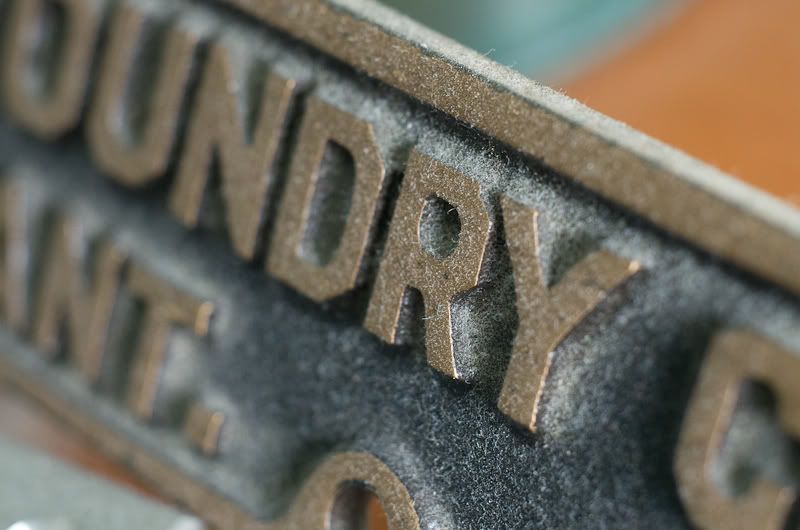


It handeded the dreaded metal spatual quite well too:
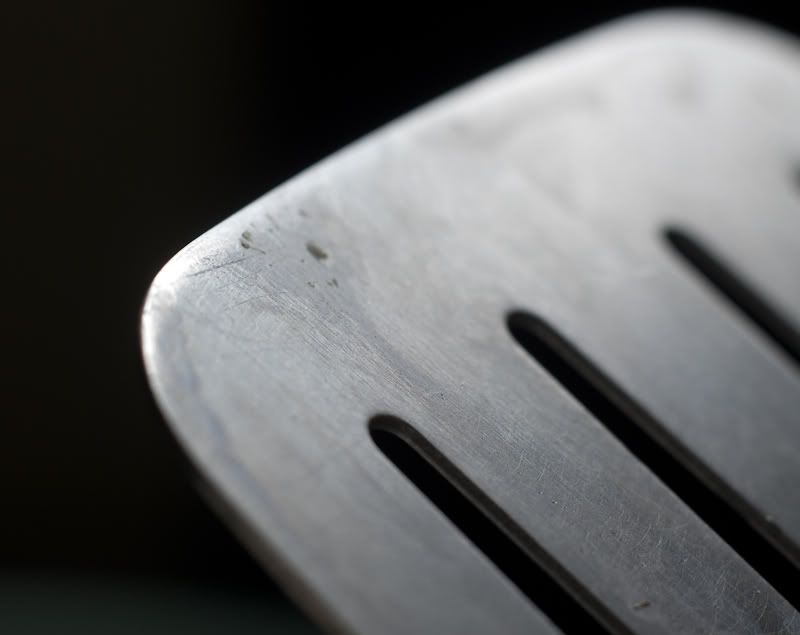 |
|
| Back to top |
|
 |
martyn_bannister


Joined: 23 May 2010
Posts: 1151
|
 Posted: Fri Jun 17, 2011 7:18 am Post subject: Posted: Fri Jun 17, 2011 7:18 am Post subject: |
 |
|
martyn_bannister wrote:
That looks pretty darn decent  |
|
| Back to top |
|
 |
MacTak

Joined: 15 Jun 2011
Posts: 108
|
 Posted: Sun Jun 19, 2011 4:24 am Post subject: Posted: Sun Jun 19, 2011 4:24 am Post subject: |
 |
|
MacTak wrote:
Finally had some sunny weather to try a little more with the lens. I was able to find some lateral CA in the corners of the money pic, but otherwise I was very impressed with the performance of the lens. Razor sharp. Very nice rendering, contrast, etc. I'd say it performs like a top notch enlarging lens. Here are a few at f8 (f5.6 seems almost, if not just, as sharp):
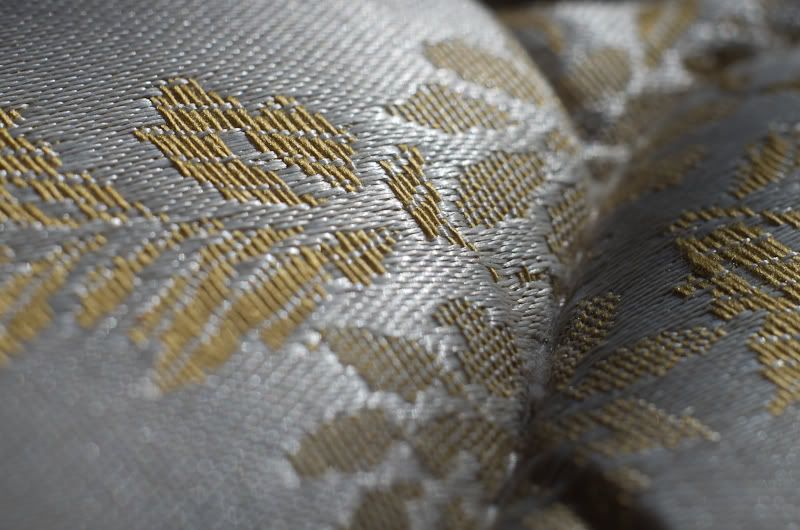

This one is wide open at f5.6:
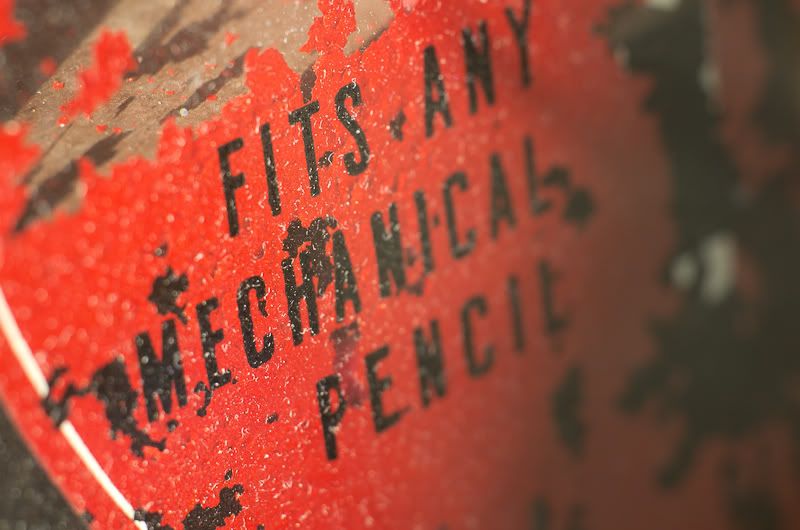
Here's one showing the aperature blade shape at f8:

It handles metal very well:
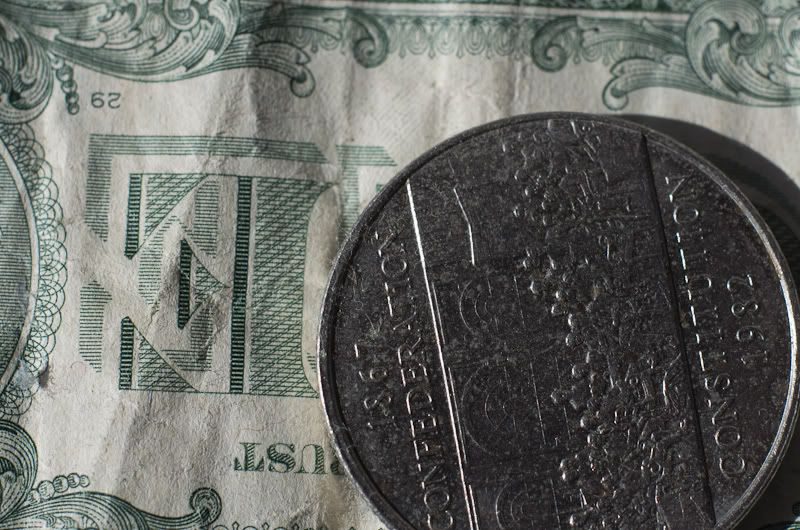
100% crop of the above:
http://s592.photobucket.com/albums/tt4/quasar41/Camera/?action=view¤t=IMP08393-1.jpg
A 100% crop from a shot of a washcloth:
http://s592.photobucket.com/albums/tt4/quasar41/Camera/?action=view¤t=IMP08333.jpg |
|
| Back to top |
|
 |
cooltouch


Joined: 15 Jan 2009
Posts: 9096
Location: Houston, Texas
|
 Posted: Sun Jun 19, 2011 5:08 am Post subject: Posted: Sun Jun 19, 2011 5:08 am Post subject: |
 |
|
cooltouch wrote:
If it's very sharp on the corners of flat subjects, it may have been a purpose built repro lens. And one where color was important, too, I'd say.
_________________
Michael
My Gear List: http://michaelmcbroom.com/photo/gear.html
My Gallery: http://michaelmcbroom.com/gallery3/index.php/
My Flickr Page: https://www.flickr.com/photos/11308754@N08/albums
My Music: https://soundcloud.com/michaelmcbroom/albums
My Blog: http://michaelmcbroom.com/blogistan/ |
|
| Back to top |
|
 |
martyn_bannister


Joined: 23 May 2010
Posts: 1151
|
 Posted: Sun Jun 19, 2011 6:07 am Post subject: Posted: Sun Jun 19, 2011 6:07 am Post subject: |
 |
|
martyn_bannister wrote:
yes, an excellent render. Tamron will be proud when they read your e-mail  |
|
| Back to top |
|
 |
simple.joy


Joined: 30 May 2022
Posts: 587
|
 Posted: Wed May 03, 2023 6:33 am Post subject: Posted: Wed May 03, 2023 6:33 am Post subject: |
 |
|
simple.joy wrote:
It's 'Why-not? Wednesday' again, so time to dig up a really old thread, right?
made me aware of a really interesting looking 70/5.6 lens recently with clear similarities to the one discussed here and also provided a link to this old topic. Because I have been quite fascinated with another (seemingly) random but interesting Tamron lens in the past my curiosity was piqued. Because of the particular look of the lens I already had a hunch about a possible connection to another brand and soon after I found the device this lens was probaby made for:
The Hirakawa 35 microfilm camera
https://www.ebay.co.uk/itm/144226434622

The lens on it doesn't show the Micro Tamron labelling, but I'm pretty sure it's the same lens, particularly given the peculiar aperture mechanism.
Here's a spec sheet for the microfilm camera:
http://www.microfilm.com/wp-content/uploads/2015/06/61.pdf
At the same time I remembered hearing about a Leica lens with the same specs and very soon after I found this:
The Leica Docuflex 35
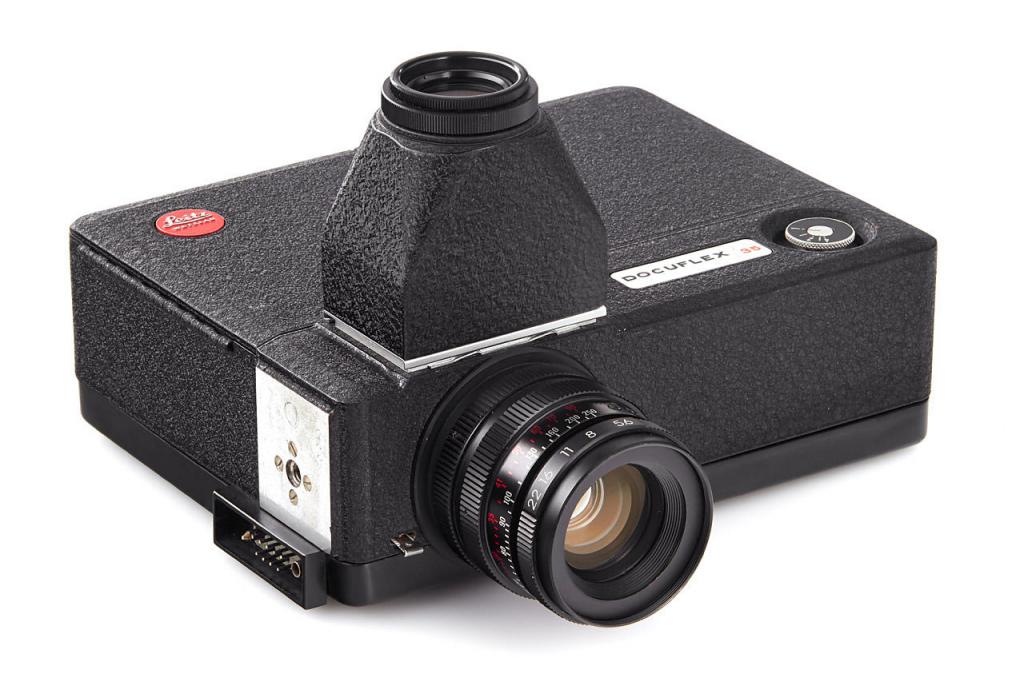
https://classic.leica-camera.com/at/de/lcc/Docuflex-35/23074-12
The camera states that it was made by Hirakawa, however also doesn't mention Tamron or Taisei Kogaku anywhere.
There seems to have been at least a third version, sold as
Koni-Omega Microfilm Camera HK-35

https://flic.kr/p/bzMEDz
as documented by Dirk HR Spennemann.
Mark (16:9) also recognized the fact that this lens exists in two variants, when it comes to focusing distance: The one in the OP goes from 40-260 cm and another one which goes from 20-140 cm.
And finally, the Leica Docuflex seems to have also been equipped with a 52 mm Elcan lens by Leitz Canada, as mentioned here by Marco Cavina:
http://www.marcocavina.com/articoli_fotografici/Leitz_Elcan_52mm_5,6/00_pag.htm

Perhaps all of this is already known, but I couldn't find any source documenting this fascinating connection, so I thought I'd just go for it. Perhaps someone here has a couple of things to add or correct on the matter.
_________________
---
Manual lens enthusiast
https://www.flickr.com/photos/simple_joy/ |
|
| Back to top |
|
 |
D1N0


Joined: 07 Aug 2012
Posts: 2530
|
 Posted: Wed May 03, 2023 8:30 am Post subject: Posted: Wed May 03, 2023 8:30 am Post subject: |
 |
|
D1N0 wrote:
Looks like that if you take out the aperture flange you'd have a 70/2.8 lens of there about.
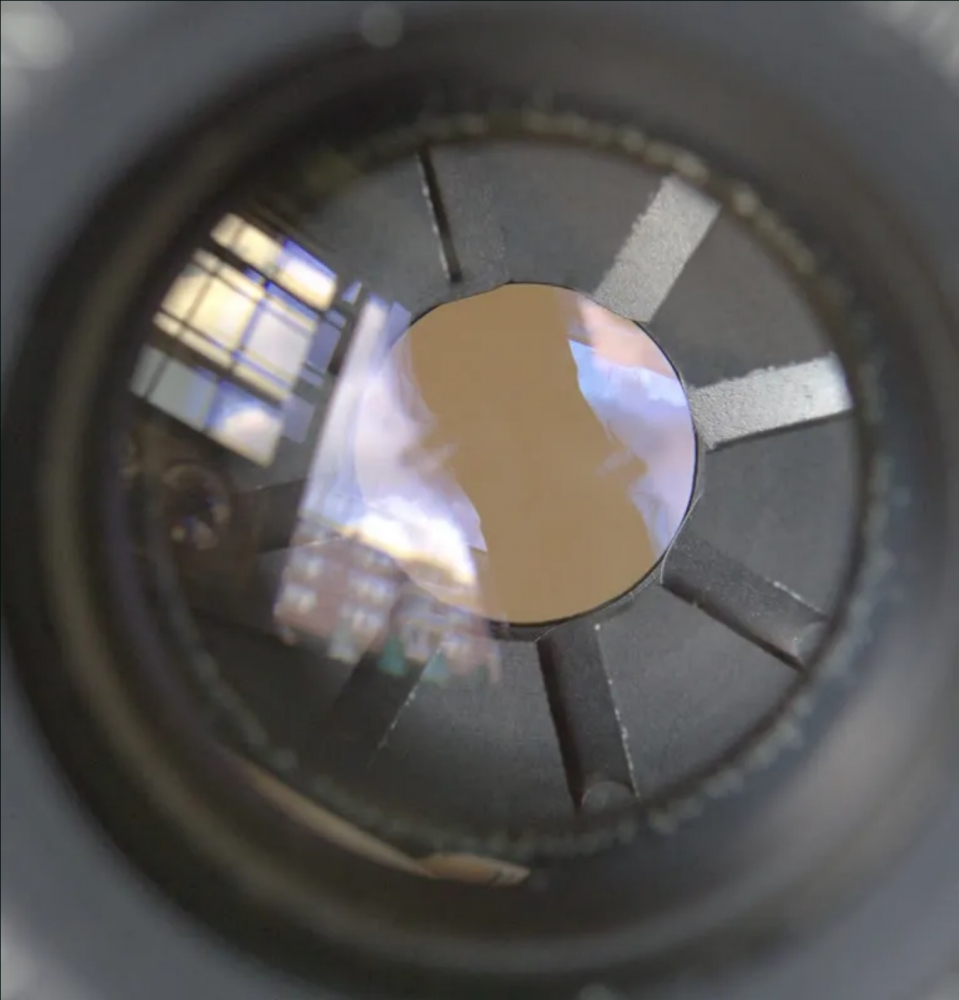
_________________
pentaxian |
|
| Back to top |
|
 |
simple.joy


Joined: 30 May 2022
Posts: 587
|
 Posted: Thu May 11, 2023 10:35 pm Post subject: Posted: Thu May 11, 2023 10:35 pm Post subject: |
 |
|
simple.joy wrote:
Found one of those lenses and while it's not labeled it's indeed suspiciously similar to the Taisei Kogaku Micro Tamron. Looks very much like Tamron to me and the serial number would fit in as well, making it a later build than the one mentioned in the OP.

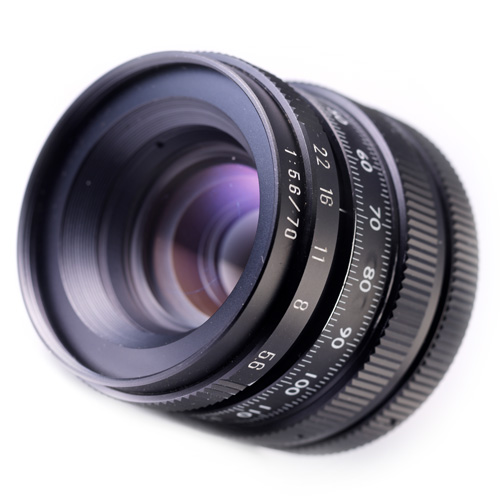
Bad weather here today, but here's a shot:

| D1N0 wrote: |
Looks like that if you take out the aperture flange you'd have a 70/2.8 lens of there about.
|
Unfortunately that doesn't seem possible, because the disk liming the max. aperture looks to be responsible for keeping the aperture blades steady. That being said, it seems to be common practice to limit the max. aperture of lenses used for microfilm application and this one at f/5.6 isn't the slowest. Most seem to be limited to f/8.
_________________
---
Manual lens enthusiast
https://www.flickr.com/photos/simple_joy/ |
|
| Back to top |
|
 |
|
|
